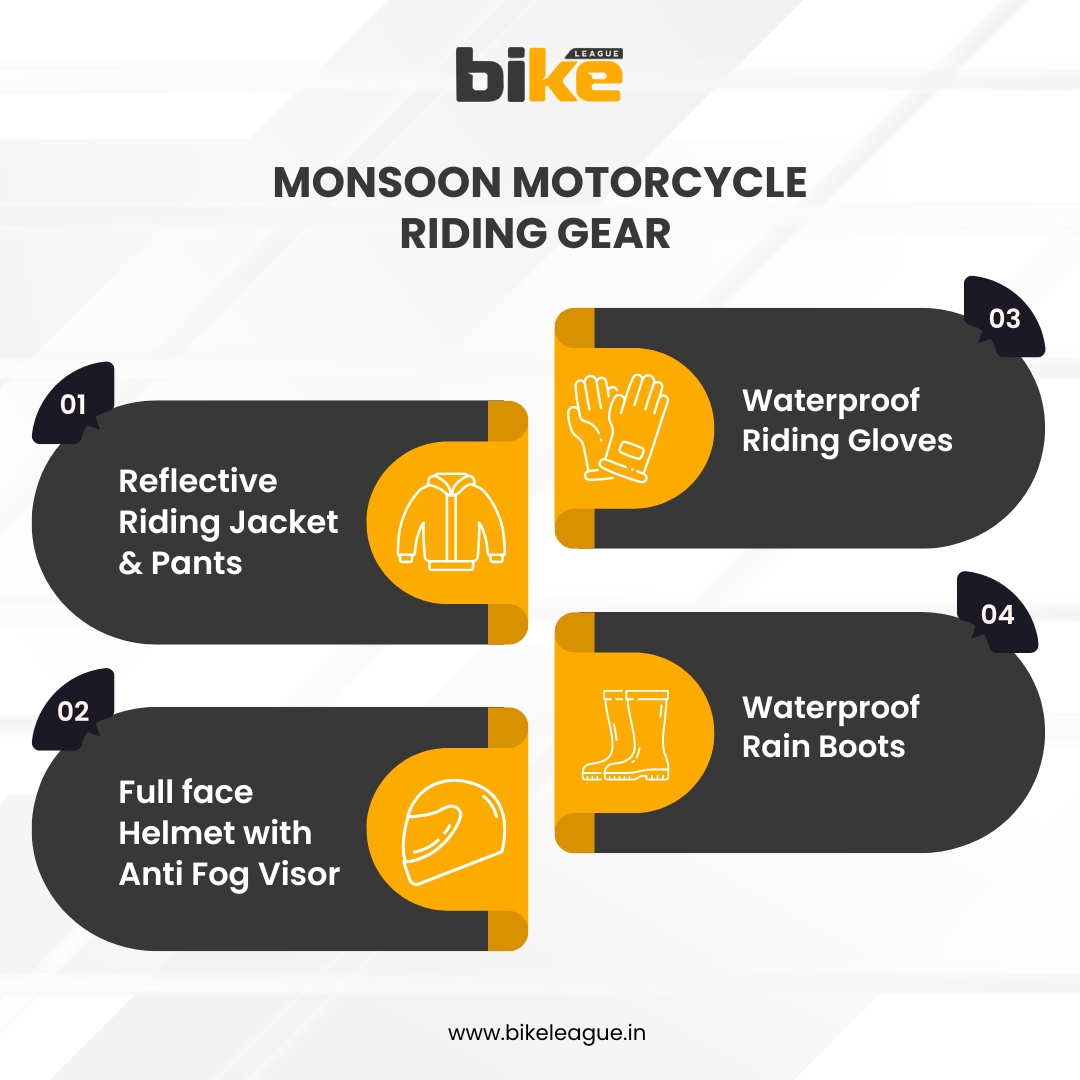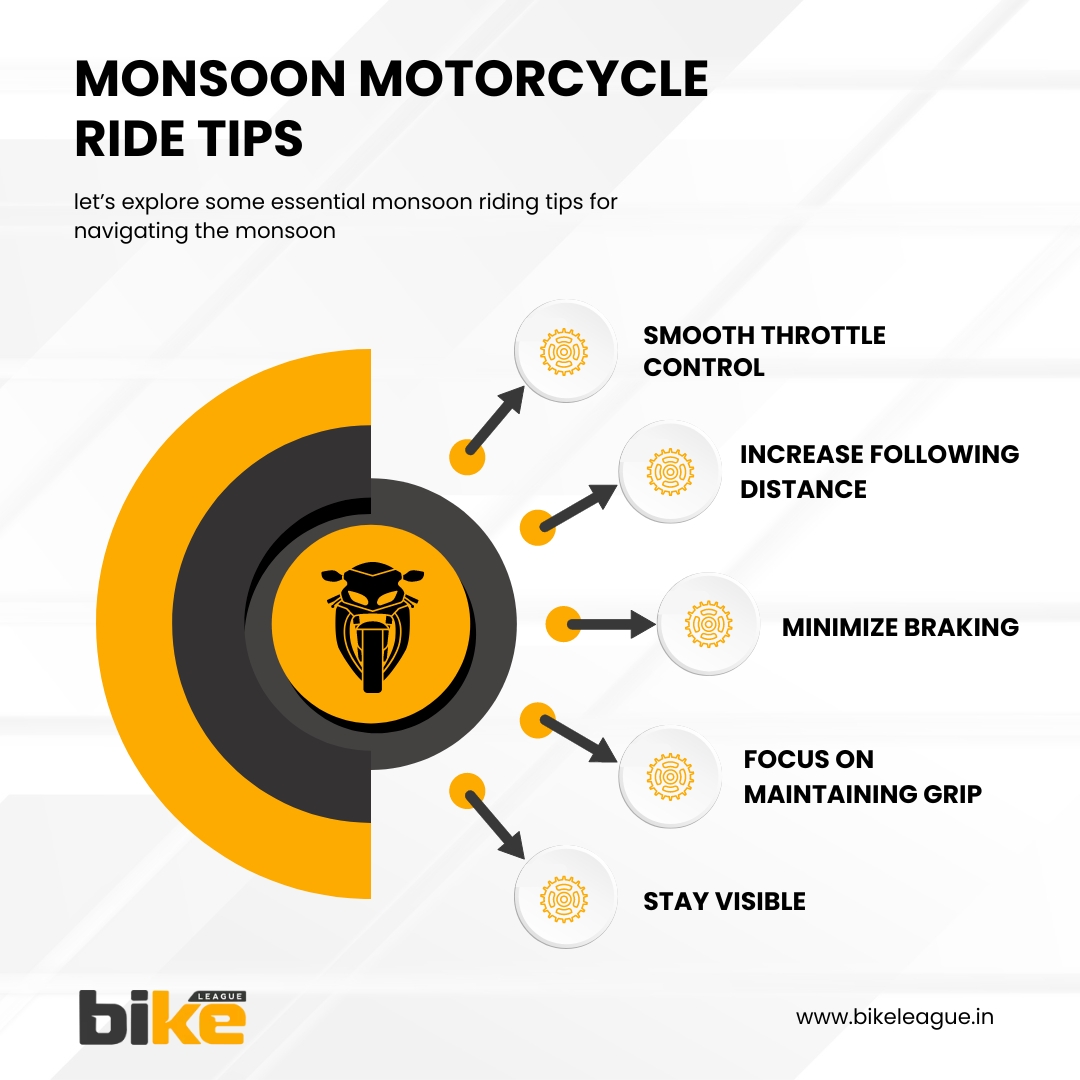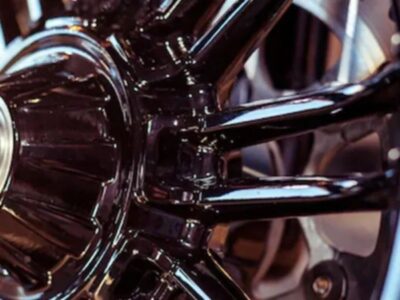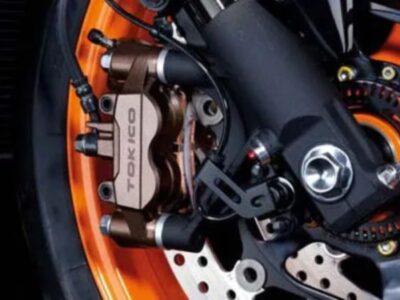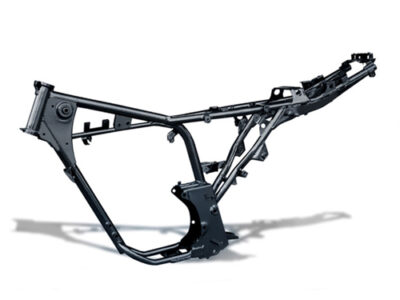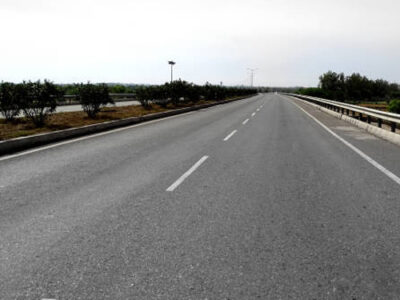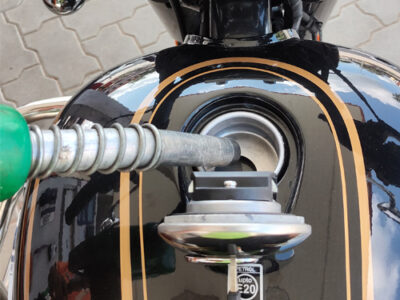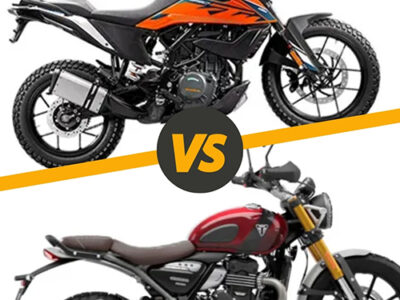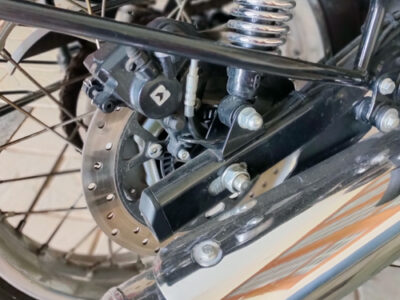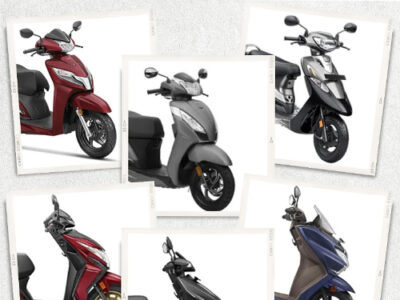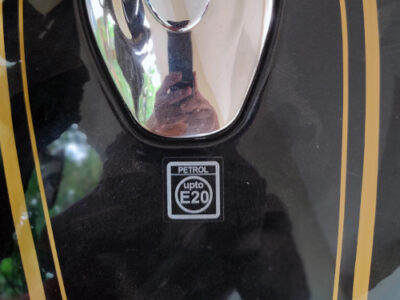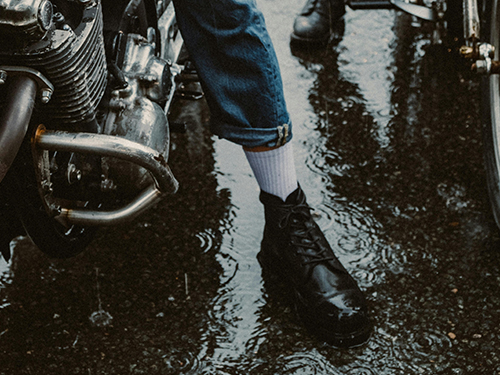
|
Getting your Trinity Audio player ready...
|
Long Story Short: Navigate India’s monsoon roads safely with our bike ride tips. Learn essential strategies for a secure and enjoyable ride.
As we all know, monsoon season is a pure form of natural blessing for all beings on Earth to thrive and flourish. It is vital for our environment, and humans can’t sit idle, and time goes ahead.
We all have a lot of monsoon travelling for our jobs and other tasks, and it’s crucial to remember that safety should always be a top-notch priority.Preparing your bike for a ride in monsoon conditions is not just a recommendation but a necessity.
The complete guide from the Bikeleague India team offers riding a bike in rain & travelling advice for all motorcyclists. We will delve into every detail, from prepping your bike to perfecting rainy-weather riding skills.
These suggestions have been thoroughly experimented with and proven effective. By adhering to these tips, you can confidently overcome the monsoon bike ride challenges in monsoon conditions and tackle any obstacle.
Preparing for the monsoon bike ride & travelling
The key to conquering the monsoon is ensuring your motorcycle is in top condition. Here’s a pre-monsoon checklist to get you started for your next monsoon motorcycle trip:
1. Tyres
The most critical aspect one should know is the tyre’s health. Tyres are the only thing that comes in contact with the ground. Keep that in mind. Ensure adequate tread depth (at least 3-4 mm) for tyres to have a good grip on wet roads. Consider switching to monsoon-specific tyres, such as the Michelin Pilot Road 4, designed for superior water drainage, as they can significantly enhance your safety during the rainy season.
2. Brakes
Have a professional mechanic inspect your brake fluid, pads, and disc rotor for wear, tear & age. If necessary, bleeding the brakes might be required to remove moisture. This process involves opening the brake bleeder valve and allowing the brake fluid to flow out, along with any trapped air or moisture. It’s an important step to ensure proper braking performance in the wet.
3. Lights
Verify that all lights, including headlights, taillights, brake lights, turn signals, and hazard lights, function properly. Lights are crucial because they can reduce overall visibility during rain.
4. Electricals
A professional mechanic should check all electrical connections for signs of corrosion or loose wires. Moisture can cause electrical problems, so ensure secure and water-resistant connections.
5. Chain and Sprockets
Lubricate the chain regularly with a waterproof chain lube to prevent rust and maintain smooth operation. Clean the chain after every ride in the rain to remove dirt and grime. Check chain slackness, too.
6. Air Filter
A clean air filter is not just a luxury; it’s a necessity. It allows the engine to breathe correctly, ensuring optimal performance. Therefore, replacing a clogged air filter is crucial to avoid any potential engine issues.
Gearing up for the monsoon motorcycle ride/trip
Proper rain gear is essential for a comfortable and safe bike riding experience. Here are the must-haves:
- Reflective Riding Jacket & Pants: Opt for a waterproof, reflective type, breathable bike riding jacket and pants when riding in the rain. Consider features like a vented design for air circulation during hot weather for all-weather use.
- Full-face Helmet: It is crucial to have a good quality full-face helmet with an anti-fog visor. The visor should be regularly cleaned to maintain clear vision.
- Riding Gloves: Waterproof gloves with a good grip will keep your hands dry and ensure control over the handlebars.
- Rain Boots: Opt for waterproof boots to protect your feet from the elements of nature.
Packing for the monsoon travelling
Always pack these additional items for your monsoon motorcycle trip:
- Puncture Repair Kit: A flat tyre can be especially troublesome in the rain. Pack a puncture repair kit to get you back on the road quickly.
- Extra Spark Plugs: Moisture can affect spark plugs. Carrying spares ensures a smooth ride in case of a malfunction.
- Microfiber Cloth: A microfiber cloth will come in handy for wiping your visor or headlight during the ride.
- Waterproof Phone Pouch: Keep your phone protected from the rain if you rely on it for navigation.
Mastering for monsoon motorcycle ride
Now that you and your motorcycle are prepared, let’s explore some essential monsoon riding tips for navigating the monsoon:
- Smooth Throttle Control: Avoid jerky acceleration or sudden braking. Maintain a smooth and consistent throttle input to prevent wheel spin or skids.
- Increase Following Distance: Compared to dry conditions, doubling or even tripling the following distance allows extra time to react to sudden stops by the vehicle ahead.
- Minimize Braking: Plan ahead and anticipate situations that might require braking. Apply brakes gently and progressively, especially when cornering. Engine braking, a technique that involves downshifting to a lower gear and letting the engine slow the bike down, can be a helpful technique to slow down.
- Focus on Maintaining grip: Ride cautiously on slippery surfaces like painted road markings, gratings, or areas with loose gravel.
- Stay Visible: For better visibility, keep your headlights on (low beam) during the day. Use your turn signals well in advance to indicate manoeuvres.
FAQ about monsoon bike ride tips
1. How should I prepare my motorcycle for monsoon riding?
Before the monsoon season, conduct a thorough inspection of your motorcycle. This includes checking the brakes, tyres, and lights and ensuring all electrical components are water-protected. Regular servicing is crucial to maintain optimal performance during the rainy season.
2. What type of tyres are best for riding in wet conditions?
Tyres with deep treads are essential for maintaining grip on wet surfaces. Dual-purpose tyres are recommended for better traction, and it’s advisable to keep tyre pressure slightly below the manufacturer’s recommendation for improved performance in the rain.
3. How can I maintain visibility while riding in heavy rain?
Wear a reflective raincoat and helmet with a clear visor to maintain visibility in heavy rain. Use anti-fog spray on your visor, and consider installing an anti-fog windshield if your bike doesn’t have one. Ensure your bike’s lights work correctly and use them even during the day.
4. What safety gear is essential for monsoon motorcycle ride?
Essential safety gear for monsoon riding includes a high-quality rain suit, waterproof gloves, and boots. Wear a full-face helmet with a clear anti-fog visor to protect against rain and wind. Reflective gear can enhance your visibility to other road users.
5. How should I handle slippery roads and waterlogged areas?
When encountering slippery roads or waterlogged areas, reduce your speed and avoid sudden braking or sharp turns. Maintain a steady throttle and use both brakes gently. If the water level is high, avoid riding through it to prevent engine damage and loss of control.
6. What should you do if a motorcycle gets off in waterlogged areas?
When a motorcycle gets off in waterlogged areas, ensure the water level is below the exhaust or the silencer before starting. Otherwise, water will get sucked into the engine via exhaust, causing severe damage to the engine.
7. What should I do if my bike skids on a wet road?
If your bike skids on a wet road, do not panic. Avoid abrupt movements and gently ease off the throttle. Steer in the direction of the skid to regain control. Keep both hands firmly on the handlebars and use light braking if necessary.
8. How can I stay dry and comfortable during monsoon rides?
To stay dry and comfortable, invest in a high-quality waterproof rain suit. Wear moisture-wicking base layers to keep sweat away from your body. Ensure your gloves and boots are waterproof and have a good grip. Take breaks in sheltered areas to avoid prolonged exposure to rain.
9.Are there any specific tips for riding a bike in rain and wet conditions during the monsoon?
Yes, there are particular riding techniques for monsoon conditions. Ride at a reduced speed, maintain a safe distance from other vehicles, and avoid sudden braking or acceleration. Use engine braking where possible and stay in the lane where the water is less likely to accumulate.
10. How can I protect my motorcycle’s electrical components during the monsoon?
Protect your motorcycle’s electrical components using dielectric grease on connectors to prevent water ingress. Cover exposed wiring with insulation tape and check for any signs of wear or damage. Ensure your battery is in good condition and fully charged.
11. What should I do to maintain my motorcycle after riding in the rain?
After riding in the rain, clean your motorcycle thoroughly to remove dirt and mud. Lubricate the chain to prevent rust and ensure smooth operation. Regular maintenance checks are essential to keep your bike in good condition.
Other related articles to monsoon bike ride
- Motorcycle chain – how to clean, adjust & maintain
- Braking in motorcycle – All expert tips for bikers
- Mileage in Two wheelers – Proven & useful tips
- Motorcycle helmet in India – All in one buying guide
- Electric scooter maintenance – Top tips for longevity
Conclusion
In India, A bike ride in monsoon conditions faces many challenges. By following these monsoon bike ride tips, you can ensure a safe and enjoyable riding experience. Remember, prioritize safety over speed, and don’t hesitate to pull over and wait out heavy downpours if necessary.
Embrace the spirit of the monsoon, conquer the elements, and create lasting memories of your motorcycle adventures! If you have any other doubts or queries about bike riding tips during rain, email us at bikeleague2017@gmail.com. We are always eager to help and assist you. Also, here are several social media platforms of Bikeleague India to raise your suspicions.

